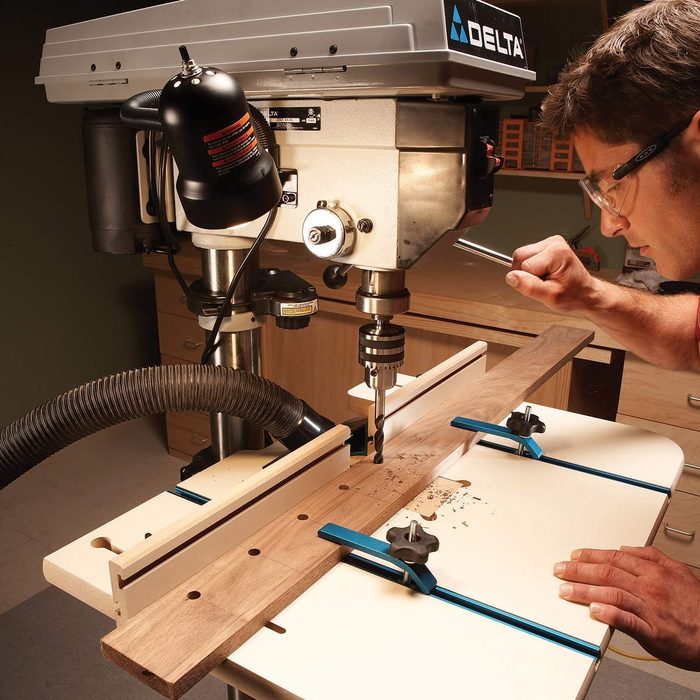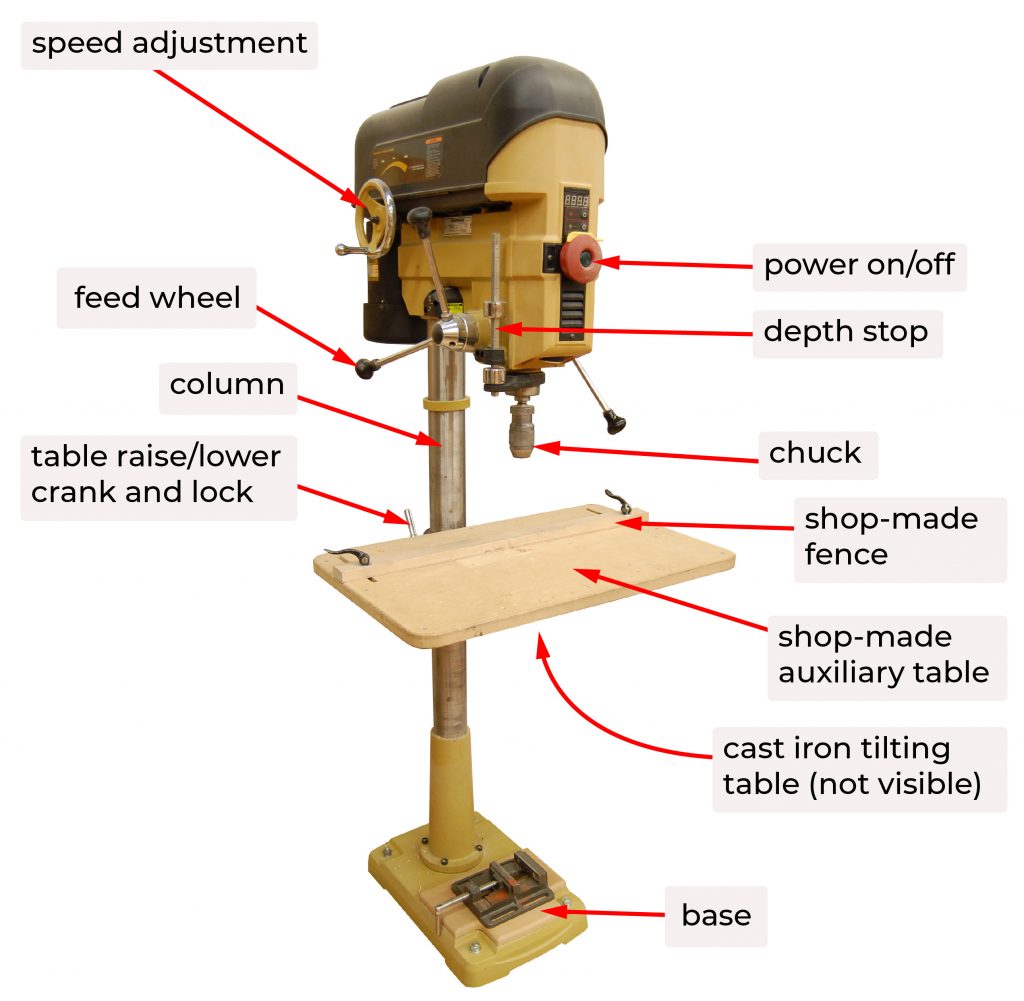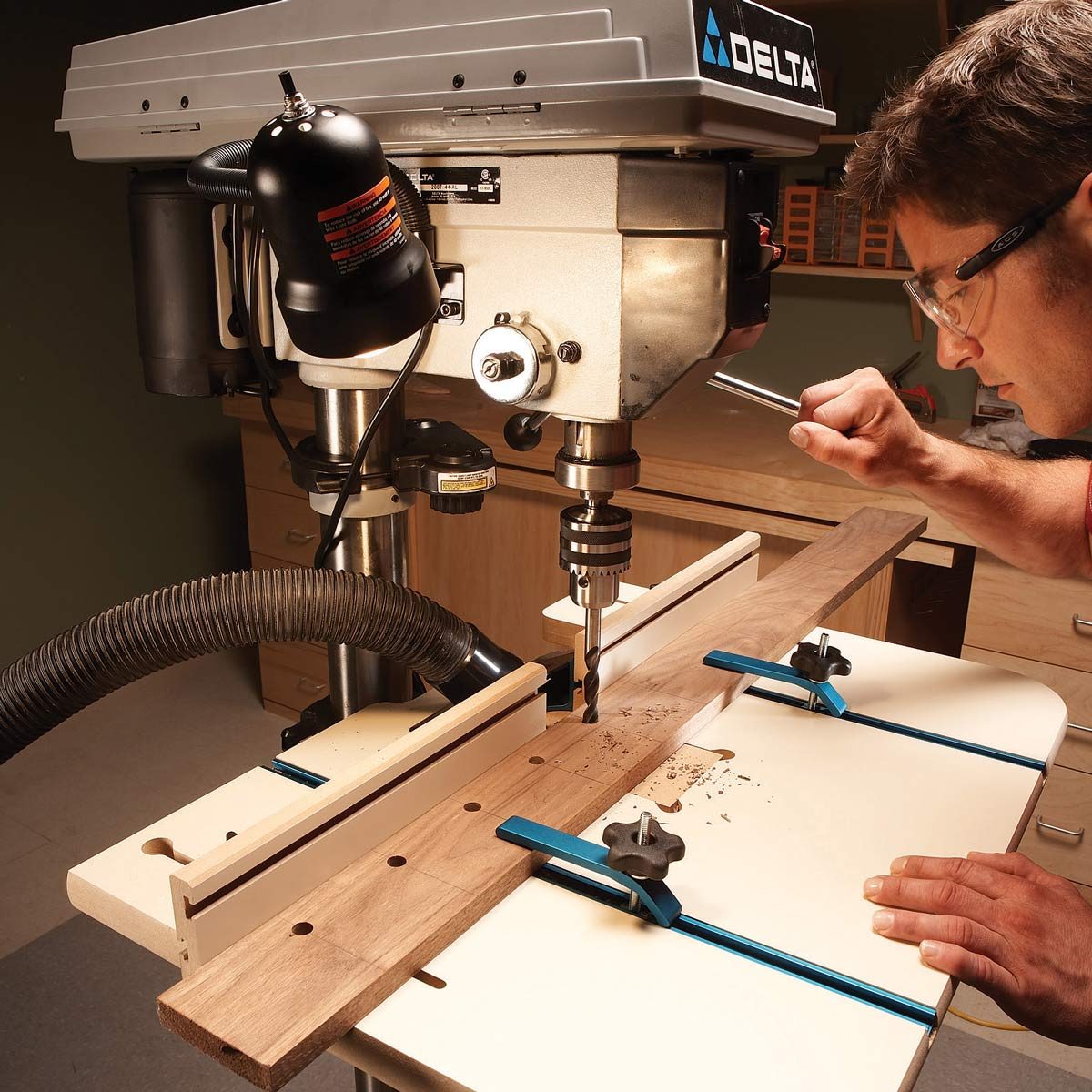So you’ve got yourself a drill press and you’re ready to start using it. But wait! Before you dive in, there are a few things you need to know about operating a drill press safely and efficiently. In this article, we’ll explore what you should do when operating a drill press to get the best results while keeping yourself and others safe. Let’s get started!
When it comes to operating a drill press, one of the most important things to keep in mind is safety. No matter how experienced you are, it’s crucial to follow proper safety precautions every time you use the machine. From wearing protective gear to securing your workpiece, we’ll cover all the essential safety tips you need to know.
But safety is not the only factor to consider. To get the most out of your drill press, you’ll also need to know how to set it up correctly, choose the right drill bit, and adjust the speed and depth of your drilling. We’ll walk you through each step, providing clear and easy-to-follow instructions.
So, if you’re ready to become a drill press pro and unleash your creativity with precision drilling, this article is just what you need. Let’s delve into the world of drill presses and discover all the tips and tricks for effective and safe operation!
- Securely clamp the workpiece to avoid movement during drilling.
- Adjust the drill press speed based on the material being drilled.
- Wear safety goggles and hearing protection to protect yourself.
- Lubricate the drill bit to prevent overheating and prolong its lifespan.
- Always keep your hands away from moving parts and the drill bit itself.
Remember to prioritize safety and take necessary precautions when using a drill press!

What Should You Do When Operating a Drill Press?
When it comes to operating a drill press, it’s essential to prioritize safety and follow the proper procedures. Whether you’re a beginner or have experience with power tools, understanding the correct steps can help you achieve accurate and efficient results while minimizing the risk of accidents. In this article, we will guide you through the essential actions you should take when using a drill press, ensuring a successful and safe drilling experience.
Preparation: Getting Ready to Use a Drill Press
Before you even start operating a drill press, it’s crucial to thoroughly prepare and set up the machine for use. By taking the time to complete these initial steps, you can ensure a smoother and safer drilling experience. Here’s what you need to do:
1. Familiarize Yourself with the Drill Press
Before using any machinery, it’s important to understand its components and functions. Familiarize yourself with the different parts of the drill press, such as the drill chuck, spindle, table, and depth stop. Refer to the manufacturer’s manual for detailed information and instructions specific to your drill press model.
Additionally, make sure to learn about any safety features and emergency stop mechanisms the drill press may have. Being aware of these features will help you operate the machine confidently and safely.
Remember, always read the manual thoroughly and adhere to the manufacturer’s guidelines and warnings.
2. Set Up a Safe Work Area
Creating a safe work environment is essential when operating a drill press. Begin by organizing your workspace, ensuring it is clean, well-lit, and free from any potential hazards. Remove any debris or objects that may obstruct your movement or the machine’s operation.
Next, secure the drill press to a sturdy workbench or stand to prevent any wobbling or movement during use. The machine should be stable and firmly anchored to provide stability and reduce the risk of accidents.
Finally, consider using additional safety measures such as wearing protective gear, including safety glasses, gloves, and hearing protection. These measures will help safeguard against potential injuries and ensure your well-being while operating the drill press for an extended period.
3. Select the Right Drill Bit
Choosing the appropriate drill bit for your project is crucial for achieving accurate and clean holes. Consider the material you will be drilling through and select a drill bit suitable for that specific material. Drill bits are available in various sizes and materials, such as high-speed steel (HSS) or carbide-tipped, each designed for different applications.
Refer to a drill bit size chart or consult with experts to ensure you select the correct bit diameter for the desired hole size. Using the wrong drill bit can lead to damages, imprecise holes, and may increase the risk of accidents.
Always inspect the drill bit for any damages or signs of wear and replace it if necessary. A sharp and intact drill bit will provide better performance and reduce the chances of the bit breaking during use.
Operating the Drill Press: Step-by-Step Guide
Now that you’ve completed the necessary preparation steps, it’s time to start operating the drill press. Follow these step-by-step instructions to ensure a smooth and safe drilling process:
1. Position the Workpiece
Place the workpiece securely on the drill press table, making sure it is centered and aligned with the drill bit. Use clamps or other appropriate methods to hold the workpiece in place, preventing any movement during drilling.
For larger or heavier workpieces, consider using support stands or blocks to provide additional stability and prevent sagging or vibrations.
Double-check the alignment and positioning of the workpiece, as any discrepancies may affect the accuracy of the drilled holes.
2. Adjust the Drilling Speed
The drill press allows you to adjust the drilling speed based on the material and drill bit size. Higher speeds are suitable for softer materials, while slower speeds are recommended for harder materials to prevent overheating and ensure clean holes.
Consult the drill press manual or a speed chart to determine the appropriate speed for your specific project. Adjust the speed accordingly using the machine’s speed control mechanisms.
It’s essential to maintain a steady and consistent drilling speed throughout the process. Rapid changes in speed can lead to an uneven and jagged hole.
3. Align the Table and Depth Stop
Ensure that the drill press table and the depth stop are properly aligned with the drill bit. Adjust the table height to match the workpiece thickness, allowing the bit to penetrate to the desired depth without going too far.
Set the depth stop to the desired drilling depth, preventing the drill bit from going any further once it reaches the set point. This feature helps you achieve consistent hole depths throughout your project.
Make any necessary adjustments to the table position and depth stop before proceeding with the drilling operation.
Additional Tips for Safe and Efficient Drilling
While following the basic steps mentioned above is essential, there are a few additional tips you should keep in mind for optimal results and safety:
1. Maintain Proper Body Positioning
When operating a drill press, ensure that your body is positioned correctly to maintain balance and control. Stand firmly in front of the machine, aligning yourself with the drill bit and the workpiece. This position allows you to have a clear view and maintain control over the drilling process.
Avoid leaning too heavily on the machine or placing any unnecessary pressure while drilling, as this can cause the workpiece to tilt or the bit to bind.
Additionally, never leave the drill press unattended while it’s running. Always turn off the machine and unplug it when you need to leave the work area.
2. Apply Steady Pressure
Apply consistent and firm pressure on the workpiece while drilling. However, avoid exerting excessive force, as it can lead to drill bit breakage, damage to the workpiece, or loss of control over the machine.
Let the drill bit do the work, applying enough pressure to prevent any slipping or bouncing but allowing the bit’s cutting edges to perform efficiently.
Remember to keep your hands and fingers away from the rotating parts of the drill press, especially the drill bit and chuck, to prevent any accidental injuries.
3. Clean and Maintain the Drill Press
Regular maintenance and cleaning of your drill press are crucial for its longevity and optimal performance. After each use, wipe down the machine to remove any dust, debris, or excess lubricant.
Inspect the drill press regularly for any worn-out parts, loose screws, or broken components. Replace or repair them as necessary to ensure safe and efficient operation.
Additionally, keep the chuck and drill bit well-lubricated to minimize friction and heat buildup during drilling. Use a suitable lubricant recommended by the manufacturer for the specific drill press model.
In Summary
Operating a drill press requires careful preparation, attention to detail, and adherence to safety guidelines. By familiarizing yourself with the machine, setting up a safe work area, selecting the right drill bit, and following the proper operating procedures, you can achieve accurate and efficient drilling results while minimizing the risk of accidents. Remember to always prioritize safety, use protective gear, and maintain your drill press regularly for optimal performance. Happy drilling!
Key Takeaways: What should you do when operating a drill press?
- Wear safety goggles to protect your eyes from flying debris.
- Securely clamp the workpiece onto the table to prevent movement.
- Select the appropriate drill bit for the material you are drilling.
- Adjust the drill press speed according to the type of material and bit size.
- Always keep your hands away from the moving parts and never reach towards the drill bit.
Frequently Asked Questions
Introduction: Operating a drill press can be a useful skill to have, but it’s important to do it safely and correctly. In this section, we’ll answer some common questions about operating a drill press.
1. How should I prepare before using a drill press?
Preparing before using a drill press is crucial for a safe and efficient operation. Start by wearing appropriate safety gear, including safety glasses and ear protection. Make sure your work area is clean and clear of any obstacles or debris. Check that the drill press is securely mounted to a stable surface, and that all the necessary tools and accessories are within reach. Lastly, double-check that the drill bits are sharp and in good condition before starting.
Once you’ve taken these preparatory steps, you can proceed with confidence, knowing that you’ve done everything you can to set yourself up for success.
2. How do I select the right drill bit for my project?
Choosing the right drill bit is essential for achieving the desired results. Consider the material you’ll be drilling into and select a drill bit that is specifically designed for that material. For example, when drilling into wood, use a wood drill bit, while for metal, go for a metal drill bit. Additionally, consider the diameter of the hole you want to create and choose a drill bit accordingly.
It’s important to note that drill bits come in different shapes, such as twist bits, spade bits, or Forstner bits, each suited for different applications. Take the time to research and understand the different types of drill bits to ensure you have the right one for your specific project.
3. How can I ensure accurate drilling depth?
To ensure accurate drilling depth, most drill presses come equipped with a depth stop feature. This feature allows you to set the desired depth before drilling, preventing you from drilling too deep or not deep enough. Adjust the depth stop according to your project’s requirements and tighten it securely.
For an added layer of accuracy, you can also use a piece of tape on the drill bit as a visual guide. Simply measure and mark the desired depth on the tape, and when the tape reaches the surface of the material, you’ll know you’ve reached the desired depth.
4. What are some safety precautions to keep in mind when operating a drill press?
Safety should always be a top priority when operating a drill press. Here are some important precautions to keep in mind:
– Always wear appropriate safety gear, including safety glasses, ear protection, and, if necessary, a dust mask.
– Keep your fingers and loose clothing away from moving parts.
– Avoid wearing jewelry or loose accessories that could get caught in the drill press.
– Ensure the material you’re drilling into is securely clamped in place.
– Use a brush or vacuum to remove chips and debris from the drill area regularly.
By following these safety precautions, you can minimize the risk of accidents and ensure a safe working environment.
5. How do I maintain and clean a drill press?
Regular maintenance and cleaning are essential for keeping your drill press in good working condition. Start by unplugging the drill press and wiping it down with a clean, dry cloth to remove any dust or debris. Inspect the drill press for any loose parts or visible signs of damage, and tighten or repair as necessary.
Next, lubricate the moving parts of the drill press, such as the chuck and quill, with a suitable lubricant. Consult the manufacturer’s instructions for the recommended lubricant and application method.
Finally, check and adjust the belt tension if needed, and inspect the electrical cords for any damage. Performing these maintenance tasks periodically will extend the lifespan of your drill press and ensure its optimal performance.

Summary
When operating a drill press, there are a few important things to remember. First, always wear safety goggles to protect your eyes from flying debris. Second, make sure to secure your workpiece properly before starting the machine. Third, adjust the drill bit height and speed based on the material you are working with. Fourth, use the proper drill bit for the job to avoid accidents. Finally, take breaks and rest your hands and arms to prevent fatigue and strain.
Overall, operating a drill press can be safe and effective if you follow these guidelines. Remember to prioritize safety, use the correct tools, and take breaks to prevent accidents and injury. Happy drilling!
